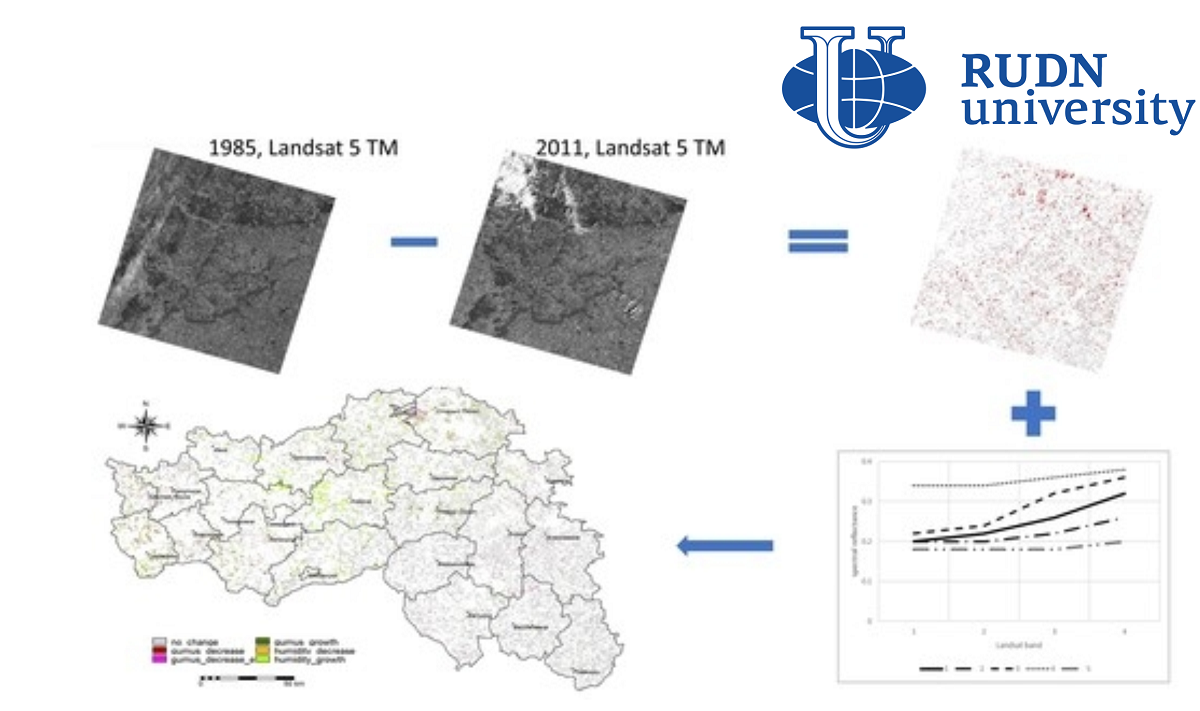RUDN Scientists Proposed Using Satellite Images to Assess the State of Chernozems

Chernozems are the most fertile soils. Agricultural crops can be grown on them even without fertilizers. With continuous long-term use, the soils are depleted — they lose fertility. To avoid this, it is necessary to regulate the intensity of use, and this requires objective and timely information about the state of the soil. However, often existing monitoring systems cannot provide such information — due to lack of funding, outdated equipment, lack of specialists. RUDN agronomists with colleagues from Belgorod State University proposed using a new method for assessing the state of chernozems — satellite photos. The researchers analyzed satellite images of the Belgorod region since 1985. This region specializes in agricultural production, and about 77% of its territories are occupied by chernozem soils.
“Basically, annual grain crops are grown in the Belgorod region — for example, wheat and barley, as well as corn, sunflower, sugar beet. At the beginning of the XXI century, the administration of the region took a course on the ecologization of agriculture and introduced the so-called adaptive landscape farming system. This led to an increase in the proportion of annual and perennial grasses in the composition of crops and a decrease in row crops, which may have reduced the agrogenic load on the soil of arable land,” Doctor of Agricultural Sciences Igor Savin, Professor of the Department of Rational Nature Management of the RUDN.
Scientists took color satellite images of Landsat TM5 for the period from 1985 to 2011. The observation interval was 15 days. RUDN agronomists chose photographs of the area taken on clear days to avoid color distortions. Then three independent experts assessed whether there were differences between the color profiles of soils in photographs from different years. According to the color change, it was concluded what transformations had occurred with the chernozem: for example, the lightening of the soil indicated its drying out and a decrease in the amount of humus — a fertile organic component. The darkening of the surface, on the contrary, could be caused by waterlogging.
The agronomists of the RUDN assessed the condition of 56% of the agricultural territories of the Belgorod region. It turned out that the color spectra of 89% of the area of the analyzed chernozem soils have not changed over the past 35 years. In the remaining soils, changes occurred: an increase in soil moisture was observed on 2.5% of the territory, an increase in humus content by 2%, and a decrease in the amount of humus by 0.9% due to plowing or soil erosion.
“Since the beginning of the XXI century, the condition of the soils in the Belgorod region has improved — in some areas the humus content in the chernozem has noticeably increased. The decrease observed in other places may be associated with plowing, as well as with the processes of water erosion of soils on the slopes. The analysis of satellite images used by us can be proposed to be used in other regions of Russia in order to promptly assess the state of local soils and regulate land use,” Candidate of Technical Sciences Peter Dokukin, Head of the Scientific Department of the RUDN.
The study is published in Remote Sensing.
RUDN summarized the results of the scientific competition "Project Start: work of the science club ". Students of the Faculty of Physics, Mathematics and Natural Sciences have created a project for a managed queuing system using a neural network to redistribute resources between 5G segments. How to increase flexibility, make the network fast and inexpensive and reach more users — tell Gebrial Ibram Esam Zekri ("Fundamental Computer Science and Information Technology", Master's degree, II course) and Ksenia Leontieva ("Applied Mathematics and Computer Science", Master's degree, I course).
The National Demographic Report, 2023 Demographic Well-Being of Russian Regions (hereinafter - the National Demographic Report) was prepared by the scientific team of the Institute of Demographic Studies of the Federal Research Center of the Russian Academy of Sciences, the Vologda Scientific Center of the Russian Academy of Sciences, Peoples' Friendship University of Russia, the Center for Family and Demography of the Academy of Sciences of the Republic of Tatarstan, as well as with the participation of leading scientists from the Republic of Bashkortostan, Stavropol Krai, Volgograd, Ivanovo, Kaliningrad, Nizhny Novgorod, Sverdlovsk Oblasts and Khanty-Mansi Autonomous Okrug–Yugra.
RUDN summarized the results of the scientific competition "Project Start: work of the science club ". Students of the Faculty of Physics, Mathematics and Natural Sciences have created a project for a managed queuing system using a neural network to redistribute resources between 5G segments. How to increase flexibility, make the network fast and inexpensive and reach more users — tell Gebrial Ibram Esam Zekri ("Fundamental Computer Science and Information Technology", Master's degree, II course) and Ksenia Leontieva ("Applied Mathematics and Computer Science", Master's degree, I course).
What is your first association with the word “laboratory”? Flasks and beakers? Microscopes and centrifuges? Yes, many of us would answer the same way.
The National Demographic Report, 2023 Demographic Well-Being of Russian Regions (hereinafter - the National Demographic Report) was prepared by the scientific team of the Institute of Demographic Studies of the Federal Research Center of the Russian Academy of Sciences, the Vologda Scientific Center of the Russian Academy of Sciences, Peoples' Friendship University of Russia, the Center for Family and Demography of the Academy of Sciences of the Republic of Tatarstan, as well as with the participation of leading scientists from the Republic of Bashkortostan, Stavropol Krai, Volgograd, Ivanovo, Kaliningrad, Nizhny Novgorod, Sverdlovsk Oblasts and Khanty-Mansi Autonomous Okrug–Yugra.